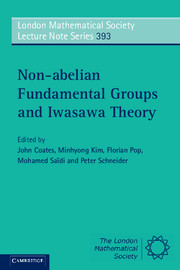Book contents
- Frontmatter
- Contents
- List of contributors
- Preface
- Lectures on anabelian phenomena in geometry and arithmetic
- On Galois rigidity of fundamental groups of algebraic curves
- Around the Grothendieck anabelian section conjecture
- From the classical to the noncommutative Iwasawa theory (for totally real number fields)
- On the MH(G)-conjecture
- Galois theory and Diophantine geometry
- Potential modularity – a survey
- Remarks on some locally ℚp-analytic representations of GL2(F) in the crystalline case
- Completed cohomology – a survey
- Tensor and homotopy criteria for functional equations of ℓ-adic and classical iterated integrals
- References
From the classical to the noncommutative Iwasawa theory (for totally real number fields)
Published online by Cambridge University Press: 05 January 2012
- Frontmatter
- Contents
- List of contributors
- Preface
- Lectures on anabelian phenomena in geometry and arithmetic
- On Galois rigidity of fundamental groups of algebraic curves
- Around the Grothendieck anabelian section conjecture
- From the classical to the noncommutative Iwasawa theory (for totally real number fields)
- On the MH(G)-conjecture
- Galois theory and Diophantine geometry
- Potential modularity – a survey
- Remarks on some locally ℚp-analytic representations of GL2(F) in the crystalline case
- Completed cohomology – a survey
- Tensor and homotopy criteria for functional equations of ℓ-adic and classical iterated integrals
- References
Summary
Introduction
The conjectures of Deligne [17], Beilinson [3] and Bloch–Kato [4] are a vast generalisation of the Dirichlet–Dedekind class number formula and Birch–Swinnerton-Dyer conjecture. They predict the order of arithmetic objects (such as class groups, Tate–Shafarevich groups, etc.) in terms of special values of L-functions. On the other hand, the aim of Iwasawa theory is to understand the Galois module structure of these arithmetic objects in terms of L-values. We roughly explain what may now be called classical Iwasawa theory. Let p be a prime. Let ℚcyc be the cyclotomic ℤp-extension of ℚ (see section 2). Let M be a motive over ℚ. We assume that M is critical in the sense of Deligne (this means that the Euler factor at infinity L∞(M, s) and L∞(M*(1), -s) are both holomorphic at s = 0, where M* is the dual motive. For details see [14]). Assume that p is a good ordinary prime for M (in the sense of Greenberg [25]. This just means that the p-adic realisation of M has a finite decreasing filtration such that the action of inertia on the ith graded piece is via the ith power of the p-adic cyclotomic character). Let Γ = Gal(ℚcyc/ℚ) ≅ ℤp and let ∧(Γ) be the Iwasawa algebra ℤp[[Γ]] (see end of Section 2). Fix a topological generator γ of Γ. Then the Iwasawa algebra and;(Γ) is isomorphic to the power series ring ℤp[[T]].
Information
- Type
- Chapter
- Information
- Non-abelian Fundamental Groups and Iwasawa Theory , pp. 107 - 131Publisher: Cambridge University PressPrint publication year: 2011
References
Accessibility standard: Unknown
Why this information is here
This section outlines the accessibility features of this content - including support for screen readers, full keyboard navigation and high-contrast display options. This may not be relevant for you.Accessibility Information
- 1
- Cited by
